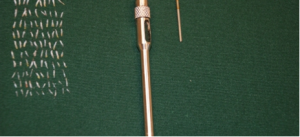Androgen alopecia, or male baldness, is one of the most common types of hair loss. Despite the name, this condition affects both men and women. Though men are primarily affected, we are beginning to see growing trends of female sufferers.
The condition occurs at different ages to varying scope. Most commonly, hair becomes thinner with age. For many people, it is a huge concern when they begin to lose hair.
Planning your surgery
He may also take “before” photos, and give you specific instructions to prepare for surgery. These may be guidelines regarding eating and drinking, smoking and taking/avoiding vitamins, supplements and medications.
Be sure to tell your surgeon if you smoke, take drugs or medications (including aspirin), or have had any previous hair-restoration surgery. You must also inform the surgeon if your body tends to form large scars or keloids.
Take this opportunity to ask any the questions you have. You may ask to see photos of recent patients before and after the procedure. Learning everything you can about your options, risks and benefits is the key to making an informed decision.
Scalp reduction surgery involves the removal of parts of the bald scalp and the stretching of the scalp which still grows hair. After stretching, the scalp is moved to a higher position on the head. This procedure may be recommended at the same time as hair grafting, as the smaller bald area requires fewer hair grafts to cover it. Good candidates for this procedure are patients with excellent hair on the sides and back of the scalp, so that these areas can be stretched upward to cover the bald area. In addition, the patient must have thick hair to be grafted as it will also be stretched and therefore must be strong and durable.
Scalp reduction (permanent solution)
Scalp reduction is normally performed using local anaesthetic on the scalp, along with a sedative to help to relax the patient and reduce anxiety. Usually, a portion of the scalp (two to five centimetres wide) can be removed in one session and the remaining skin is then stitched back together. Newer methods of scalp reduction may also be used. These include scalp expansion and scalp extension and are explained below.
Scalp expansion (permanent solution)
Scalp expansion involves balloon-like devices, called tissue expanders, being implanted under the sides and back of the scalp where the hair is still growing.
These are gradually inflated over a four to twelve week period, resulting in an increase in the amount of loose hair bearing tissue as the skin stretches.
The following scalp reduction surgery creates a greater amount of loose bald skin than would be possible if it hadn’t been stretched before surgery.
Scalp extension (permanent solution)
Scalp extension involves the use of a surgical device that is made of two rows of hooks, connected by elastic bands. This device is placed on the under surface of the scalp during the first scalp reduction procedure. Over a one-month period, the tension in the bands gets tighter, gently pulling upwards on the hair-bearing tissues. This loosens and stretches the scalp, allowing for another scalp reduction to be done.
With scalp extension, a faster series of scalp reductions can be done within a 30- to 90 – day period. In the past, some scalps could not be reduced at all and those that could be reduced often took a year or longer for the procedures to be completed. The treatment is much quicker now!
Scalp extension has some of the benefits of scalp expansion, but causes less discomfort and deformity. With this procedure, however, the amount of stretched tissue is generally less than can be achieved with scalp expansion devices.
Hair transplants (permanent results)
A hair transplant is the only treatment that produces permanent results. During a hair transplant, the patient’s existing hair follicles are moved from the back of the head to the bald area. The hair follicles at the back of the head are genetically conditioned to remain in place for a person’s whole life. They continue to produce new hair even after a transplant, therefore giving lifelong results. With today’s methods, we can achieve a natural result without signs of a transplant. Older methods, which resulted in a ‘doll’s hair look’, are not used at Australia Plastic surgery.
The hair follicles are moved one by one which changes their natural form.
Natural hair growth can also stop for other reasons, e.g. after operation on a tumour, following an accident, after certain skin conditions or a burn. This condition can usually be treated with a hair transplant.
Other treatments (temporary solutions, effect wears off once treatment stops)
Laser (temporary solution)
Laser stimulates the bottom of the hair, increasing the scalp’s blood circulation and providing more blood to the hair follicles. In some cases, laser can awaken dormant hair follicles and cause them to produce hair again. The hair may become thicker and stronger and occasionally new hair is produced. To achieve a positive effect using laser, the treatment must be repeated several times a week. The effect wears off once treatment stops. Treatment with laser can be combined with a hair transplant and medication for hair loss.
Medicines (temporary solution)
Medical treatments are often used to stop hair loss. In some cases, there have even been signs of new hair growth. However, the effect wears off if treatment is stopped, which means that we recommend a permanent treatment to maintain the effect. Medicines can be combined with a hair transplant and/or laser.
Regaine (temporary solution)
Regaine or minoxidil is a liquid liniment used locally on the area affected by hair loss. The lotion is best applied in the morning and at night, and is used to stimulate hair growth and minimise further hair loss. The treatment is suitable for both men and women.
Propecia(temporary solution)
Propecia or finasterid is a prescribed treatment for hair loss in the form of a tablet to be taken once a day. It is used to stop hair loss and stimulate new hair growth. If the treatment is stopped, any effect wears off with 6 months. After 9-12 months, the patient’s hair will have reverted to its original state. It has not been proven to have any effect on bald patches and advanced baldness. Propecia should not be used by women.
Patients normally experience swelling and numbness for the first few days following the procedure. Because the skin needs time to soften, tightness in the scalp is also common for several months after the operation. Scabbing is also common. Both scalp reduction and hair transplant are done under local anaesthetics.
- You will be going home on the same day, the wound on the scalp requires no dressing after the procedure.
- The scalp will remain numb for 12-24 hours, after that you will require simple analgesia.
- A follow up appointment will be arranged in 7-10 days after surgery.
- You will need to avoid: sun exposure for a week and any strenuous work that may contribute to an increase in your blood pressure.
You should be able to slowly resume normal daily activities over the next several days.
- Shampooing and combing should be avoided for at least 5-7 days.
- Most patients will be able to return to work within 3-5 days following the procedure.
- Strenuous activity should be kept to a minimum for 10 days.
- Most patients who decide to undergo scalp reduction are pleased with the results.
- While there may be some scarring around the incision, it is normally covered by hair. A hair transplant procedure can be used to better cover the scars.
What Are The Risks Associated With This Procedure?
Plastic surgery, like any surgical procedure, carries inherent risks and potential complications.
Please read our Risks and Complications of Plastic Surgery page.








